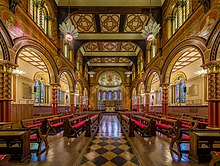Victor Negus
Sir Victor Ewings Negus, MS, FRCS (6 February 1887 – 15 July 1974) was a British surgeon who specialised in laryngology and also made fundamental contributions to comparative anatomy with his work on the structure and evolution of the larynx.
In this period of his career following the Second World War he also worked on the anatomy of the paranasal sinuses, and played a key role in rebuilding and establishing collections of animal dissections used by comparative anatomists.
[3][5] After passing the required examinations, Negus proceeded in 1909 to the next stage of his basic medical education at the nearby King's College Hospital, at that time located on Portugal Street between the Strand and Lincoln's Inn Fields.
[7][n 3] The postgraduate stages of Negus's training involved specialisation in diseases of the ear, nose and throat, a direction influenced and guided by the otorhinolaryngologist St Clair Thomson (1857–1943).
[2][n 4] Following his discharge from the army, Negus, again with the advice and guidance of St Clair Thomson, resumed his studies and preparations for a career in throat surgery.
[1] To gain further experience, he spent periods of time abroad studying with renowned laryngologists: firstly with Emil Moure and Georges Portmann in Bordeaux, France; and secondly with Chevalier Jackson in Philadelphia, USA.
Rather than be apprenticed to a leading surgeon in his ENT (ear, nose and throat) speciality, he undertook basic research on the structure of the larynx that led to a higher degree in 1924 and the publication of books and papers on the topic in later years.
[1] It was during this period, following his return from the USA, that Negus both promoted the methods and tools he had seen used in Philadelphia by Jackson, and worked to improve the designs of the endoscopes and other equipment used in ENT surgery.
[5] In parallel with his career as a throat surgeon at a teaching hospital, Negus become a leading expert on the comparative anatomy of first the larynx and then the nose and the paranasal sinuses.
This strand of his professional life started with the research he carried out in his thirties in the 1920s that eventually led to his degree of Master of Surgery (MS), awarded by the University of London.
[5] This work started as early as 1921 in the laboratories of the Royal College of Surgeons of England, whose museum housed the collections of animal specimens gathered by the anatomist John Hunter.
Working on these specimens, and adding to them with others supplied by the Zoological Society of London, Negus carried out meticulous dissections that enabled him to trace the stages of evolution and development of the larynx across a wide variety of animals.
[17] In addition to this, Negus gave the Arris and Gale Lecture on 28 April 1924 at the Royal College of Surgeons, with his talk titled "On the Mechanism of the Larynx".
[1][22] This work was covered in Negus's Hunterian Lecture, delivered on 20 May 1954 at the Royal College of Surgeons under the title "Introduction to the Comparative Anatomy of the Nose and Paranasal Sinuses".
[2] Negus's legacy in this field was assessed in 1986 by the British surgeon and comparative anatomist Sir Donald Frederick Norris Harrison, himself an expert on the mammalian larynx.
[25] Writing further on the subject in 1995, Harrison states that Negus's "pioneer research into the mechanism of the animal larynx [...] established him as a unique comparative anatomist.
[1] When Negus had been training as a surgeon, laryngology, rhinology and otology had been part of general surgery, but this was changing with the advent of ENT (ear, nose and throat) medicine as a combined and specialised discipline.
Negus and colleagues attempted to set up the necessary structure within the Royal Society of Medicine to represent their profession as an emerging speciality, but the regulations in place did not allow the type of organisation they had planned.
[11] This reorganisation was taking place against a background of immense change in how medicine was practised in the UK, due to the advent of the National Health Service (NHS).
This award, which had only been made thirty times since 1802 prior to the 1969 ceremony, is presented for "liberal acts or distinguished labours, researches and discoveries, eminently conducive to the improvement of natural knowledge and of the healing art.
He has always been known to us as a great research worker and scientist, whose labours earned him the Lister Medal, a man of exceptional integrity and industry and a persistent advocate of the value of tradition in its best sense.
Responding, Negus thanked the members of the Council for the award and for the privilege of having used college facilities since 1921, concluding: "I take this honour as a mark of approval for any work I have done, and I feel I can now sit back and leave it to others to carry on.
[1][n 15] Negus's status in the history of laryngology in the UK was remarked on in his obituary in The Times, which stated that he "made a worthy fourth to Morell Mackenzie, Felix Semon, and St Clair Thomson".
[n 16] In due course, biographical entries appeared in volume 6 of Lives of the Fellows of the Royal College of Surgeons of England (1988) and in the Oxford Dictionary of National Biography (2004).
[48] Additional collections of bisected animal heads prepared by Negus are held at the Grant Museum of Zoology and Comparative Anatomy in London.


